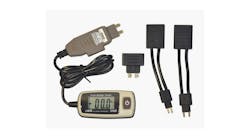Fluid management is critical to keeping costs low in vehicle service applications, as it can help service shops track the dispense of oils, coolant, antifreeze and other fluids. Effective fluid management in automotive, heavy truck, heavy equipment, and municipality and fleet vehicle service shops can reduce costs and improve operational efficiency, while generating helpful data about dispense history. Complete engineered systems most effectively deliver these benefits, as components are designed to work together to deliver the greatest amount of accurate data possible.
Why choose fluid management?
Effective fluid management systems allow vehicle service shops to control expenses by effectively managing their inventory of fluids such as oils, gear lube, coolant and antifreeze. These fluids are purchased and stored in large volumes and dispensed as needed; fluid management systems control and track that dispense. One benefit offered by fluid management systems is that metering can ensure the dispense of precise volumes, avoiding costly, unnecessary overfills. With an increasing number of vehicles on the road today requiring expensive synthetic oils rather than conventional ones, precise dispense and inventory management is key to keeping costs down.
In addition to improving the precision of dispensed volumes, an effective fluid management system creates efficiencies in shop operations. With the large volumes of fluids being stored, it can be extremely difficult to track how much fluid is remaining so that re-orders are placed at the right time – too early, and the shop may not have space to store replacement fluid drums; too late, and the shop may need to close or stop performing certain services until inventory is restocked. Similarly, fluid management systems can track volumes of used or wasted fluids, ensuring that disposal is timely to avoid the hassle of full waste containers.
The final, critical reason for implementing a high-quality fluid management system is the system’s ability to recall transaction data. The detailed dispense history provided by effective fluid management systems can help shop managers in visualizing production and discovering patterns or workflow roadblocks in order to improve efficiency. Additionally, having a detailed dispense history recorded by the fluid management system at the time of dispense and stored for future reference means that if customers request information about work that was done on their vehicle, such as confirming that the correct oil was used in an oil change or the proper volume of coolant replaced, shop managers can easily access and share that information.
In short, fluid management systems deliver a range of benefits to vehicle service shops, including increased inventory control, greater dispense precision, improved operational efficiency and detailed dispense history.
Components of a fluid management system
Before discussing the benefits of fluid management systems further, it is important to establish precisely what is meant by “fluid management system,” for the purposes of this article. The Graco Matrix Total Fluid Management System is an example of such a system, and can be used to model both the necessary and optional components of a fluid management system and their impact on a vehicle service shop.
There are a number of components that, while not technically part of the fluid management system, are critical to dispense. Chief among these is a reliable and precise pump, such as a Graco Fire-Ball 300 Series oil and grease pump. The pump, along with hose reels, diaphragm pumps for waste oil evacuation and other material handling equipment, are central to the actual dispensing and disposal of the materials being monitored by the fluid management system.
With the Graco Matrix system, the only components necessary for functioning are the Matrix software and transceiver coupled with either a Matrix Meter and/or Tank Level Monitor. The software is a Windows-based system that can be configured easily by users to suit any particular dispense environment. Given that no two shops are the same, it is important for end users to be able to configure their system to meet their shop’s needs, rather than reconfigure their shop to fit into the requirements of the fluid management system.
The transceiver is connected back to the user’s PC and functions as a wireless hub specifically for the Matrix system. Up to eight transceivers can be configured in a single system, giving a great deal of flexibility in shop size and layout, and the secure network set up by the transceiver(s) ensures that the Matrix system functions without relying on the shop’s existing wireless network. Because of these transceivers, installation of Matrix is simpler and less costly than competing systems: the wireless setup makes installation far less labor-intensive than that of wired systems.
Nearly every one of the thousands of Matrix systems installed globally uses the Graco Matrix Meters, and many include some or all of the other optional components. The Matrix Meter is the device in the technician’s hand when dispensing is taking place. It is a pre-set smart meter, meaning that users can pre-set dispense volumes, ensuring that the system will stop automatically after a pre-set volume of the given fluid has been dispensed. The Matrix meter includes internal metering, electronics, wireless communication and a built-in solenoid, giving technicians the ability to control pin codes, work orders, dispense authorization and dispense itself from within the service bay, saving time away from the work area and therefore improving efficiency.
Other components available through the Matrix system include pump air control and tank level monitors. The pump air control is integrated into the system in order to improve security and eliminate the risk of unauthorized or unintentional dispense. With the pump air control installed, the Matrix system turns off air to the pumps whenever there are no authorized jobs in the system. This ensures that no unauthorized or unrecorded dispenses can take place. More importantly, though, it ensures that if there is a leak in a hose downstream of the pump, there will be no positive pressure and therefore eliminates the risk of leaks leading to the fluid running out of the bulk supply, and onto the shop floor. Without intelligent pump air control, this kind of costly, messy waste may go undetected in the event of a hose leak.
The tank level monitors are designed for both supply and waste tanks, and can be set up to check fluid levels on a schedule, automatically measuring fluid levels in the tank and reporting them to the parts and/or service manager. The monitors have automatic email capability, and can notify both shop managers and either fluid suppliers or oil recyclers in the event of supply tanks nearing empty or waste tanks nearing full.
Cost savings and improved efficiency
As noted above, many of the Graco Matrix system installations include many, if not all, of the possible available components. Beyond the convenience of ordering equipment from the same manufacturer, many shops implement a complete Matrix system because complete fluid management solutions provide benefits that surpass the sum of their parts. The Matrix system can be composed of just the software and transceiver; however, using the Matrix meters, pump air control, tank level monitors and related Graco material handling products allows shops to reap the benefits of a fully-integrated system.
Take, for example, implementing tank level monitors. These monitors work with the Graco software to send programmed updates on tank level status, ensuring that shops always have an appropriate supply of fluid and that waste is disposed of when necessary. Eliminating the need for manual fluid level checks and the risk of running out of fluid or space for waste delivers significant operational benefits to the shop. Specifically, any downtime associated with unexpectedly running out of a fluid, or running out of waste fluid storage space, is completely eliminated through the implementation of the Matrix system with tank level monitors.
Additionally, a number of the components come together to form the most accurate and complete possible dispense history. Well-designed systems such as the Matrix can answer and record the “five Ws” for every dispense job: who performed the dispense, what specific fluid was dispensed, where in the facility this dispense took place, when it occurred, why (i.e., which work order and customer record the dispense was tied to), and even how much fluid was dispensed.
The complete picture offered by top-quality fluid management systems can give shop managers insight into how to improve shop efficiency, and can provide a record should the customer or shop require verification of any of these details. With this kind of comprehensive data, shop owners and managers can make smart business decisions about their inventory and process. In combination, this comprehensive data and the system’s improved efficiency and precision prove that fluid management is critical to managing costs and ensuring success in vehicle service applications.


